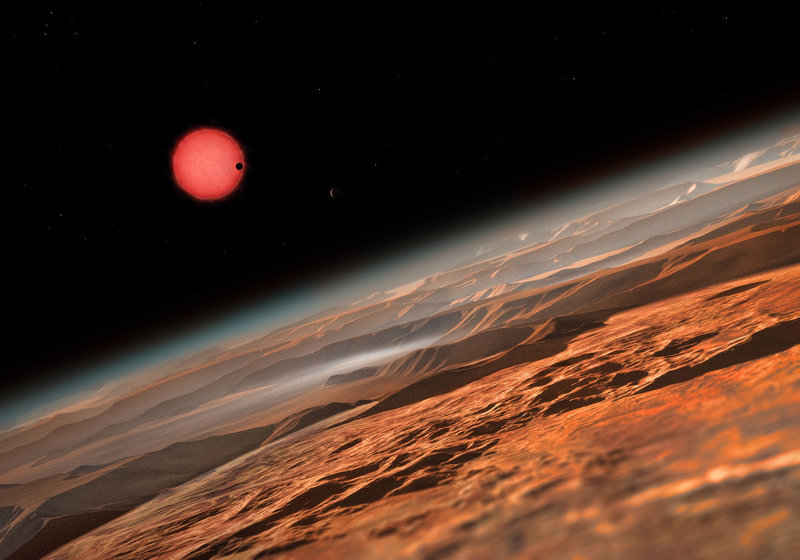Astronomers have found three potentially habitable planets near a star close to us.

What could be the view from one of the three found planets
Astronomers have discovered three planets the size of the Earth, rotating in orbits around an ultracold dwarf at a distance of only 40 light years from us. They are potentially habitable and are ideal for studying the atmosphere, in particular, searching for signs of extraterrestrial life on them.
Stars that whose effective temperature does not exceed 2700 K are called ultracold dwarfs. The 2MASS J23062928-0502285 star found is about eight times smaller than the Sun. The planets revolve around it in such a way that one side of them all the time is turned towards the star.
')
As a result, they must have one side hot and the other cold, and the gap between them can provide comfortable conditions for the existence of protein life. The nearest planet to the star turns around it for a day and a half.
“Planets are as big as Earth, the conditions on them should be moderate, the possibility of their habitability cannot be excluded. They are well suited to explore the atmosphere, ”rejoices Julien De Wit, an MIT researcher. - This is all that we know at the moment. "
It is interesting that until recently it was believed that ultracold dwarfs do not have planetary systems at all, and therefore they were excluded from consideration when searching for exoplanets in large and serious projects. But a group of brave researchers decided to build a network of small telescopes capable of detecting planets in stellar systems using the transit method.
Called TRAPPIST (Transiting planets and planetesimals small telescopes), the system surveyed 60 ultracold dwarfs closely spaced to us. The difficulty of studying exoplanets in this way is that, unlike the Kepler telescope, which can study thousands of stars at the same time, astronomers had to look at the stars one by one, waiting for a successful discovery. The found star received the short name TRAPPIST-1.
“Now we know that these systems may have such planets,” says Devit. “And the planets revolving around such stars are great for studying such advanced things as atmospheric characteristics.” The atmosphere of the planet can be studied by analyzing the light of its stars passing through it, and such dim stars create ideal conditions for this.
Now that the astronomical community has become interested in this system, the researchers are preparing to study its characteristics in detail using the Hubble telescope. In the near future, scientists are awaiting the entry into operation of an advanced James Webb space telescope, which can “see” the presence of elements such as water, ozone and carbon dioxide in the planet’s atmosphere. The purpose of the research will be the search for signs of life on exoplanets.
Source: https://habr.com/ru/post/393553/
All Articles